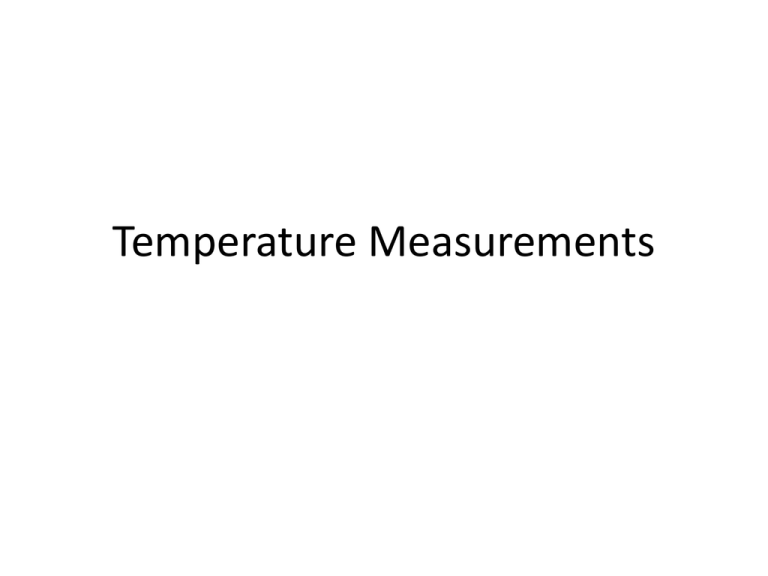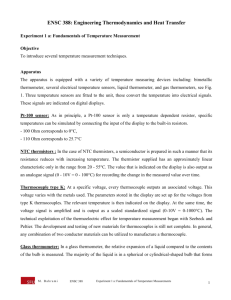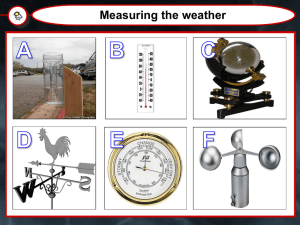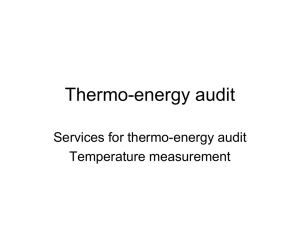Temperature Measurements
advertisement

Temperature Measurements Interesting Information about Temperatures Kelvin K Absolute zero 0 Celsius °C −273.15 Lowest recorded natural temperature on Earth (Vostok, Antarctica - 21 July 1983) 184 −89 −128 Celsius / Fahrenheit's "cross-over" temperature 233.15 −40 –40 Fahrenheit's ice/salt mixture Water freezes (at standard pressure) Average surface temperature on Earth Average human body temperature Highest recorded surface temperature on Earth (Al 'Aziziyah, Libya - 13 September 1922) But that reading is queried. Water boils (at standard pressure) Gas flame Titanium melts The surface of the Sun 255.37 273.15 288 310.0 ±0.7 −17.78 0 15 36.8 ±0.7 0 32 59 98.2 ±1.3 331 58 136 373 ~1773 1941 5800 100 ~1500 1668 5526 212 ~2732 3034 9980 Comment Fahrenheit °F −459.67 Glass Thermometers • Glass Thermometer: Consists of a glass tube filled with mercury or some other liquid, which acts as the working fluid. Temperature increase causes the fluid to expand, so the temperature can be determined by measuring the volume of the fluid. Such thermometers are usually calibrated so that one can read the temperature simply by observing the level of the fluid in the thermometer Alcohol Thermometers • Alcohol thermometer is an alternative to the mercury-in-glass thermometer, and functions in a similar way. • But unlike mercury-in-glass thermometer, the contents of an alcohol thermometer are less toxic but will evaporate away fairly quickly. • The liquid can be pure ethanol or toluene or kerosene or Isoamy acetate, depending on manufacturer and working temperature range. Since these are transparent, the liquid is made more visible by the addition of a red or blue dye. One half of the glass containing the capillary is usually enamelled white or yellow to give a background for reading the scale. • The range of usefulness of the thermometer is set by the boiling point of the liquid used. In the case of the ethanol-filled thermometer the upper limit for measurement is 78°C Bi-Metallic Thermometor • A bimetallic strip is used to convert a temperature change into mechanical displacement. The strip consists of two strips of different metals which expand at different rates as they are heated, usually steel and copper, or in some cases brass instead of copper. The strips are joined together throughout their length by riveting, brazing or welding. The different expansions force the flat strip to bend one way if heated, and in the opposite direction if cooled below its initial temperature How does Bi-Metallic Thermometer work? • A direct indicating dial thermometer (such as a patio thermometer or a meat thermometer) uses a bimetallic strip wrapped into a coil. One end of the coil is fixed to the housing of the device and the other drives an indicating needle Resistance Thermometers • Also called resistance temperature detectors or resistive thermal devices (RTDs), are temperature sensors that exploit the predictable change in electrical resistance of some materials with changing temperature. As they are almost invariably made of platinum, they are often called platinum resistance thermometers (PRTs). Resistance Thermometers Thermocouples • A thermocouple is a device consisting of two different conductors (usually metal alloys) that produce a voltage proportional to a temperature difference between either end of the pair of conductors. Thermocouples are a widely used type of temperature sensor for measurement and control and can also be used to convert a heat gradient into electricity Theory of Thermocouples • Seebeck Effect T S V Types of Thermocouples Type Alloys S Temperatur Temperature e range °C range °C (continuous) (short term) K Chromel (90 percent nickel and 10 percent chromium) Alumel (95% nickel, 2% manganese, 2% aluminium and 41 µV/°C 1% silicon) 0 to +1100 −180 to +1300 J Iron – Constantan 0 to +750 N Nicrosil (Nickel-Chromium-Silicon)–Nisil ( Nickel-Silicon) 39 µV/°C R S B Platinum–rhodium alloy containing 13% rhodium for one conductor and pure platinum for the other conductor 90% Platinum and 10% Rhodium (the positive or "+" wire) and a second wire of 100% platinum platinum–rhodium alloy for each conductor. One conductor contains 30% rhodium while the other conductor contains 6% rhodium 55 µV/°C −180 to +800 0 to +1100 −270 to +1300 10 µV/°C 0 to +1600 −50 to +1700 10 µV/°C 0 to 1600 −50 to +1750 10 µV/°C +200 to +1700 0 to +1820 T Copper–Constantan 43 µV/°C −185 to +300 −250 to +400 E Chromel - Constantan (68 µV/°C) 0 to +800 −40 to +900 Infrared Thermometers • Infrared (IR) light is electromagnetic radiation with a wavelength longer than that of visible light measured from the nominal edge of visible red light at 0.74 micrometers (740 nm), and extending conventionally to 300 micrometres (300,000 nm). These wavelengths correspond to a frequency range of approximately 1 to 400 THz and include most of the thermal radiation emitted by objects near room temperature. Microscopically, IR light is typically emitted or absorbed by molecules when they change their rotational-vibrational movements. Infrared thermometer (Pyrometer) • Infrared thermometer (Pyrometer) has an optical system and detector. The optical system focuses the thermal radiation onto the detector. The output signal of the detector (Temperature T) is related to the thermal radiation or irradiance j* of the target object through the Stefan–Boltzmann law, the constant of proportionality σ, called the Stefan-Boltzmann constant and the emissivity ε of the object. j* T 4 Specs of IR Thermometer • Specifications of portable handheld sensors available will include ratings of temperature accuracy (usually with measurement uncertainty of ±2 °C/±4 °F) and other parameters. • The distance-to-spot ratio (D:S) is the ratio of the distance to the object and the diameter of the temperature measurement area. For instance if the D:S ratio is 12:1, measurement of an object 12 inches (30 cm) away will average the temperature over a 1inch-diameter (25 mm) area. The sensor may have an adjustable emissivity setting, which can be set to measure the temperature of reflective (shiny) and nonreflective surfaces. Liquid Crystal Thermometers • A liquid crystal thermometer or plastic strip thermometer is a type of thermometer that contains heatsensitive (thermochromic) liquid crystals in a plastic strip that change color to indicate different temperatures. Liquid crystals possess the mechanical properties of a liquid, but have the optical properties of a single crystal. Temperature changes can affect the color of a liquid crystal, which makes them useful for temperature measurement. Disposable liquid crystal thermometers have been developed for home and medical use. For example if the thermometer is black and it is put onto someone's forehead it will change colour depending on the temperature of the person.











